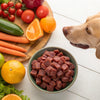Is Kibble Fattening for Dogs? Understanding the Nutritional Impact of Kibble on Your Furry Friend
- Houndsy
Table of Contents
- Introduction
- The Nutritional Landscape of Kibble
- The Connection Between Kibble and Weight
- Strategies for Managing Your Dog’s Weight
- Conclusion
Introduction
Did you know that nearly 60% of dogs in the United States are classified as overweight or obese? This staggering statistic raises an important question for all of us who love our furry companions: Is kibble fattening for dogs? As pet owners, we strive to provide the best for our pets, yet the choices we make regarding their diet can have significant implications for their health and wellbeing.
Kibble is one of the most popular choices for dog food, largely due to its convenience and affordability. However, the nutritional content of kibble varies greatly between brands, and some formulations may indeed contribute to weight gain. In this blog post, we will explore the relationship between kibble and canine weight management, examining the implications of kibble on your dog's health.
By the end of this article, you will have a comprehensive understanding of how kibble can affect your dog's weight, factors that contribute to weight gain, and strategies to ensure a balanced diet. We will also look into the innovative solutions we offer at Houndsy, such as our Kibble Dispenser, designed to enhance your dog's feeding experience while encouraging portion control.
So, let’s embark on this journey to understand whether kibble is fattening for dogs and how we can make informed decisions for our beloved pets.
The Nutritional Landscape of Kibble
Understanding Kibble Composition
Kibble is primarily made from a combination of proteins, carbohydrates, fats, vitamins, and minerals. However, the quality and source of these ingredients can vary widely among brands. Many commercial kibbles include:
- Animal by-products: These can be lower-quality protein sources.
- Fillers: Ingredients such as corn, wheat, and soy are often added to bulk up the food but provide limited nutritional value.
- Artificial additives: Preservatives, colors, and flavors that may not be beneficial for your dog’s health.
Given this, it’s critical to read ingredient labels carefully. High-quality kibbles should list real meat as the first ingredient and contain wholesome, recognizable ingredients.
The Caloric Impact of Kibble
Most kibbles are calorie-dense, meaning they pack a lot of energy into a small volume. For dogs, this can become problematic if their calorie intake exceeds the calories they burn through daily activity. Factors such as age, breed, size, and activity level all play a role in determining your dog's caloric needs.
Portion Control: A Key to Preventing Weight Gain
One of the most effective methods for managing your dog’s weight is controlling their portion sizes. It's easy to overfeed with kibble, especially if you rely on free-feeding, where food is available at all times. This can lead to excessive calorie consumption and, ultimately, weight gain.
At Houndsy, we understand the importance of portion control, which is why we developed our Kibble Dispenser. With features designed for convenience and precision, it helps ensure your dog receives the right amount of food every meal, promoting a healthier lifestyle.
Factors Contributing to Weight Gain in Dogs
While kibble can contribute to weight gain, it is not the sole factor. Here are several key elements that can influence your dog's weight:
- Genetics: Some breeds are predisposed to obesity.
- Age: Older dogs may have decreased metabolism and activity levels.
- Activity level: Less active dogs will burn fewer calories.
- Treats: High-calorie treats can add up quickly.
- Health conditions: Some medical issues may lead to weight gain.
Understanding these factors can help you create a balanced and healthy feeding routine for your furry friend.
The Connection Between Kibble and Weight
The Link Between Kibble Quality and Weight Gain
Research has indicated that not all kibbles are created equal. Lower-quality kibbles that are high in fillers and low in nutritional value can lead to weight gain. In contrast, higher-quality kibbles that contain adequate protein and fewer fillers may support a healthier weight.
Moreover, studies show that dogs fed a diet that includes fresh food or lower-calorie options tend to have lower obesity rates compared to those on a standard kibble diet. This highlights the importance of choosing a kibble that is not only convenient but also nutritionally sound.
The Role of High-Carbohydrate Diets
Many kibbles are high in carbohydrates, which can lead to increased insulin levels and fat storage if not balanced with sufficient fiber and protein. This carbohydrate overload can contribute to weight gain, especially in dogs with less active lifestyles.
Signs of Overweight Dogs
It's essential to recognize the signs of obesity in dogs, which include:
- Lack of a visible waist when viewed from above
- An inability to feel the ribs without excessive pressure
- A sagging belly
- Lethargy and decreased activity levels
If you notice any of these signs, it may be time to reevaluate your dog’s diet and consult with a veterinarian.
Strategies for Managing Your Dog’s Weight
Implementing Portion Control
Establishing a consistent feeding schedule with measured portions can significantly help in managing your dog’s weight. Avoid free-feeding and instead offer meals at specific times of the day.
Using our Houndsy Kibble Dispenser can streamline this process. With its precision dispensing system, you can ensure that your dog receives the correct portion every time, greatly reducing the risk of overeating.
Choosing the Right Kibble
When selecting kibble for your dog, look for:
- High-quality protein sources as the first ingredient.
- A balance of carbohydrates, proteins, and fats.
- Minimal fillers and artificial additives.
- A nutritional profile that matches your dog's specific needs.
Incorporating Fresh Foods
Consider supplementing your dog’s kibble with fresh, whole foods. Ingredients like carrots, green beans, and lean meats can enhance the nutritional value of their diet while providing variety and improving palatability.
Regular Exercise
Physical activity is crucial for maintaining a healthy weight. Incorporate regular exercise into your dog’s routine, such as daily walks, playtime, or engaging activities like agility training. Exercise not only helps control weight but also strengthens the bond between you and your pet.
Monitoring Progress
Keep track of your dog’s weight and body condition regularly. Use a body condition score (BCS) chart to help assess whether your dog is within a healthy weight range. If you notice any changes, consult your veterinarian for guidance.
Conclusion
The question of whether kibble is fattening for dogs is multifaceted. While kibble can contribute to weight gain when not managed effectively, it is essential to recognize that the quality of the kibble, portion sizes, and overall lifestyle choices play significant roles in your dog's health.
At Houndsy, we are committed to simplifying and elevating the dog-feeding experience. Our Kibble Dispenser not only promotes portion control but also complements your home décor with its mid-century modern design. We believe that feeding your dog should be a joyful ritual, one that enhances both their well-being and your day-to-day life.
As you reflect on your dog’s feeding routine, consider the changes you can implement to promote a healthier lifestyle. Are you ready to take the first step toward managing your dog’s weight effectively? Explore our Houndsy Kibble Dispenser today to help make feeding your furry friend a breeze! Order Now.
FAQ
Can feeding my dog kibble make them overweight?
Yes, if kibble is not portioned correctly and is of low nutritional quality, it can contribute to weight gain in dogs.
What are the key factors that contribute to weight gain in dogs?
Factors include genetics, age, activity level, portion sizes, and the types of food being fed.
How does portion control help manage my dog's weight?
Portion control ensures that your dog does not consume more calories than they expend, which is crucial for maintaining a healthy weight.
How important is exercise in helping my dog lose weight?
Regular exercise is vital for weight management as it helps burn calories and improves overall health.
What should I look for in a high-quality kibble?
Look for real meat as the first ingredient, a balanced nutritional profile, minimal fillers, and no artificial additives.
What strategies can I use to help my dog lose weight?
Implement portion control, choose high-quality kibble, incorporate fresh foods, and maintain a regular exercise routine.
How can I monitor my dog’s weight effectively?
Regularly check your dog’s weight and assess their body condition using a body condition score chart to ensure they remain within a healthy weight range.












